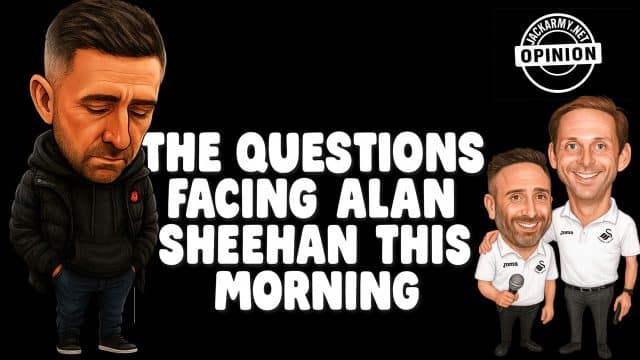Despite the criticism aimed at last weekend’s opinion piece, yesterday’s 4–1 home defeat to Ipswich Town confirmed that its tone and theme were entirely justified. Swansea City delivered the most abject performance of the Alan Sheehan era, second best in every department, lacking coherence, intensity, and even the basic effort required to compete.
This wasn’t just a tactical failure. It was a performance devoid of intent. Two touches in the opposition box during the entire first half at home tells its own story: unacceptable, uninspired, and unrepeatable.
Last week’s article – Swansea City Fans Lose Faith as Alan Sheehan Faces Growing Pressure Over Poor Form
 Unfortunately, this wasn’t an isolated collapse. While no previous display has matched the ineptitude of yesterday, the signs have been there. Even after a win against Norwich and a draw at Charlton, the warning lights were flashing. That Norwich result remains our only win in the last seven league games. This is not a blip. It’s a systemic issue and one the ownership will be keen to address, and quickly.
Unfortunately, this wasn’t an isolated collapse. While no previous display has matched the ineptitude of yesterday, the signs have been there. Even after a win against Norwich and a draw at Charlton, the warning lights were flashing. That Norwich result remains our only win in the last seven league games. This is not a blip. It’s a systemic issue and one the ownership will be keen to address, and quickly.
Across those seven games, we’re averaging fewer than four shots on target per match. That statistic alone exposes the heart of the problem: a team incapable of creating chances. Despite the summer rebuild, the side lacks pace, movement, direction—and most worryingly, intent. The same issues that plagued previous managers persist: slow build-up play, backwards and sideways passing, and hospital balls that kill momentum before it begins.
We wake this morning to find ourselves 18th in the Championship. We’re closer to the relegation zone than the play-offs. All four of our league wins have come against teams below us. This is not a temporary dip in form. It’s a structural failure that demands intervention.
Alan Sheehan will face difficult questions in the next 24–48 hours. Some will come from CEO Tom Gorringe, but the most pressing will come from above, from those who’ve invested heavily in this squad. And they didn’t invest to see Swansea languishing in the bottom quarter of the table a third of the way into the season. Or as they will see it they did not make significant investment for minimal return
So what will those questions cover?
Strategic and Tactical Accountability
First, the game plan, or lack thereof. Sheehan must explain how we ended up second-best in midfield and transitions. What metrics are being used to assess player performance and tactical execution? And how do those metrics align with what we’re seeing on the pitch week after week?
Squad Investment and Utilization
This will sting. Swansea backed Sheehan with one of the highest net spends in the division. So where’s the return? Have we recruited the right profiles? This isn’t just Sheehan’s burden, it’s one for the recruitment team too. Adam Worth and others must answer for decisions like Manuel Benson’s signing. What data supported his fit for Swansea City? Why has the summer recruitment yielded so little impact, not just in performance, but in securing regular places in the team?
Is this poor management or poor recruitment? It’s a valid question. And even if the answer is both, we must ask: are we getting the best out of this squad? Probably not. But more importantly, how good is this squad, really? Was this summer’s spend a statement, or a misread?
Mentality and Leadership
The owners must assess whether the dressing room still backs the manager. What does Sheehan believe, and what evidence supports that belief? Yesterday’s team looked fragile under pressure. Does Sheehan have leadership on the pitch to counter that fragility? What resilience exists in this squad?
And beyond the pitch, what’s the plan to climb the table? Yesterday’s crowd was bolstered by Ipswich’s travelling support. The empty seats at kick-off told one story; the exodus by the 80th minute told another. Fans are angry, disconnected, and disillusioned. That must change. Do the owners believe the fans still trust the leadership? If not, something has to give.
What Next?
The final question is simple: what changes can Sheehan realistically make? We all know the definition of insanity and that means if nothing changes, everything stays broken. So what tactical shifts, personnel adjustments, or structural changes are within his reach? If the answer is “not enough,” then the conclusion becomes inevitable.
This isn’t about one bad result. It’s about a pattern. A disconnect between investment and output. A manager who must either reassert control or admit that things are slipping away. Sheehan won’t volunteer his failings—but Cravatt, Cohen, and Gorringe will be weighing them heavily this morning.
And this morning, the silence will be louder than any excuse.

This article first appeared on JACKARMY.net.


2 replies
Loading new replies...
Tommy Hutchison
Ivor Allchurch
Join the full discussion at the Welcome to the Lord Bony Stand →